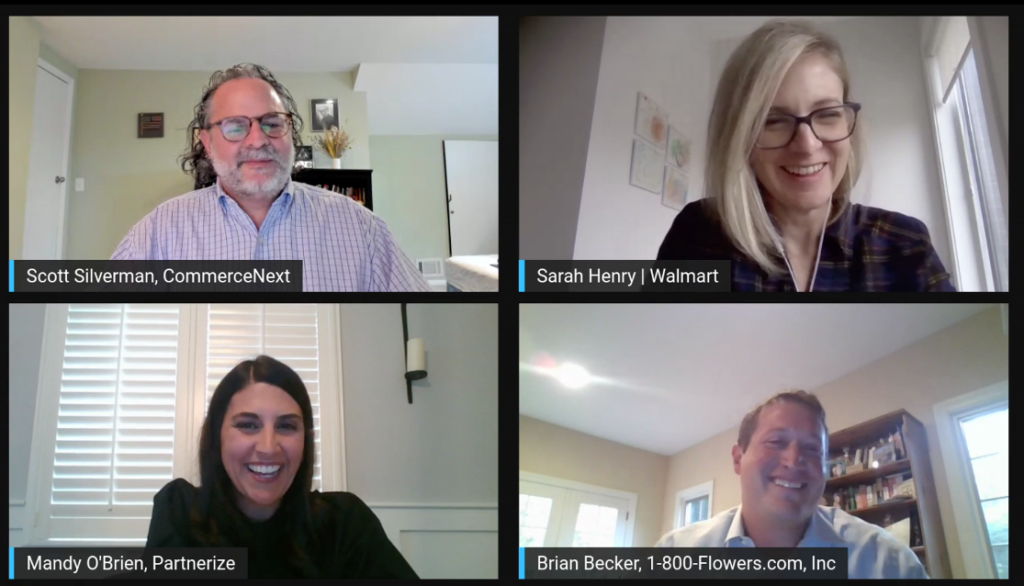Happy 50th Webinar-versary to us!
In this week’s extra special celebratory webinar, we talked about the joys, the pitfalls, the challenges and the evolved benefits of partner marketing. In a time of rising acquisition costs and lower ROI, it appears it’s time we all embrace these kinds of alternatives to paid search and social.
What We Learned
In just one hour, we learned about the evolution of partner marketing, it’s challenges, it’s benefits and how it looks in the real world utilized by two top brands. Here’s a taste of what they had to say:
- Partner marketing is now more diverse than ever, and affiliate marketing has taken a back seat to new, more creative partners.
- While harder for some than others, partner marketing is an ideal way to bring more collaboration and alignment throughout your organization internally, as it requires high cross-function across many teams to optimize execution.
- To choose the right partner, know your incentives and ensure everyone, internally and in your partner’s organization are rallying around them. Choose true collaborators.
- The most valuable partners are those that add value to the customer journey.
Be ready to embrace incrementality, lifetime value and other relatively new measurement metrics across teams.
Speakers:
- Brian Becker, VP, Content & Innovation, 1-800-FLOWERS.COM, Inc.
- Sarah Henry, Head of Content & Influencer Marketing, Walmart
- Mandy O’Brien, Senior Director of Customer Success, Partnerize (pre-panel presentation also by Partnerize)
Watch the replay here — or — read the full recap below.

The Evolution of Partner Marketing: From Affiliate to Influencers
First, what is it?
Partnership marketing, as defined by Partnerize in their presentation, is:
All the activities that allow a company to develop, design, execute plans to find the right partners, recruit them, agree on mutual outcomes, enable them, incentivize them, manage, measure and report on outcomes.
Traditionally, retailers equated this strictly with affiliate marketing. For a number of reasons, and a number of years, affiliate marketing has been an antiquated form of partnership marketing. Brands had to wait for publishers to apply to the program, rather than having a proactive mechanism to recruit them. Organizations and the affiliate channel had little ability to integrate or adapt tool systems, which led to several more relational drawbacks, including siloed data views. Affiliate also relied solely on last-click measurement, which meant the most positive results came from coupons and discount partners, limiting the type of partners onboarded, and thus, limited companies’ opportunity to scale.
Now, the world of partnerships is vastly different, having evolved away from the cash-back/coupon model. Holistic attribution and commissioning advances have let partners who aren’t last-click finally earn. Strategy and tech silos created an inability for partner program managers to communicate the benefits and needs effectively to the rest of the company. Now, every department has skin in the game—business development, PR, social, marketing all touch partnerships. Measurement has shifted, too, with metrics like incrementality, lifetime value, profitability and margin gaining in the mix, making it easier for teams to prove out this channel’s value.
In Practice: Walmart Moves Away From Affiliate Using New Set Of Criteria
Sarah Henry from Walmart explained exactly how they redesigned their partnership program to be more diverse and comprehensive leveraging four criteria:
- The relationship must have the ability to span beyond any one moment in time or campaign.
- There must be something uniquely positioned about the partner.
- The partnership has to add value to the customer journey and solve a problem for them.
- The partnership typically includes a component of content media and creation.
The Worthy Challenges and Rewards of Partner Marketing
By now, most know that having a diverse array of partnerships can help companies achieve the external omnipresence needed to compete in today’s crowded market. Working with influencers, publishers, creators, etc. gives all companies an avenue and advantage to be creative, reaching consumers in new and surprising ways. As Henry describes it, partnerships are the newest old method of transitioning from transaction to building relationships and brand equity.
But, often, it’s the internal reorganization and evolution of thinking that presents the most pushback to expanding the channel.
Common Organization Challenges
Partnerize characterized the internal challenges into three main buckets:
- The learning curve requires comprehensive strategic procedures and planning, and multiple team investment.
- Teams that are accustomed to owning the message need to be more flexible, like with influencers and editorial who have their own voices and can’t be prescribed.
- New, more advanced measurement approaches have to be embraced across the organization.
Broader Organizational Benefits
And the benefits to an organization, both inside and out, also outweigh the challenges. The new nature of partnership marketing necessitates that organizations be more collaborative, aligned and accountable across teams in ways that no other channel encourages. And, because performance based metrics are necessarily utilized by this channel, more teams get into the great habit of quantifying impact through performance, aligning goals and KPIs across teams more than ever before.
In Practice: Walmart And 1-800-FLOWERS.COM Embrace Cross-Function To Optimize The Channel
For Walmart and 1-800-FLOWERS.COM, this is certainly the case. With objectives equally rooted in brand and performance marketing, she finds the management of their partnerships to be highly cross-functional internally. Henry’s team works most with Marketing, Customer Science and Insights, Analytics, channel marketers, category marketing teams, plus Creative and Biz Dev. Within the commerce partnership area of the channel, the execution becomes even more cross-functional, as no one person can bring all the expertise needed to execute the initiatives. Within both brands, the marketing, business strategy, product, technology and design teams all participate in new and existing collaborations with the search, vetting and execution of partnership activities.
The Right Mix And Measurement Of Partner Marketing
With everyone internally aligned on what it will take to maximize the benefit of their partnerships, the last questions remain: What kinds of partners do we need, and how will we measure their success? It’s certainly complex to get off the ground, but more and more businesses are learning the payoff.
Types Of Popular Partnerships
We polled our own webinar audience to gauge their current investment in the channel—about a third of the brands who joined are already immersed in influencer, brand-to-brand and Tik Tok marketing.
Walmart, a known vet in partnership with a robust team, looks for partnerships designed to create storytelling moments that leverage unique credibility and discovery in the space. Henry breaks down her program into three areas:
- Content: Includes partnerships with affiliate editorial/branded and custom content/TV.
Influencers/networks/creators: This involves less prescriptive messaging and is instead more of an “always on,” steady drumbeat of partners talking about Walmart in their own voices. - Commerce: These are end-to-end partnerships offering bespoke journeys that tap into where consumers are finding inspiration (e.g. making dinner, refreshing a living space, etc.) and translating that point in the journey into an easier buying purchase.
- Brian Becker’s team at 1-800-FLOWERS.COM ensures everyone is rallying around incentives and that they are choosing true collaborations. Now, they have a robust (and ever-growing) program that taps brand collaborations, brand ambassadors, affiliate, media collaborations and influencers.
Tips For Working With Creators
Overall, Becker and Henry agreed there are some general ways to work with creators and manage the role they play in digital marketing and ecommerce. With unique social opportunities like Tik Tok, it’s key to “play the long game,” as Henry says, ensuring the content isn’t transactional within such an entertainment-focused channel. In the same vein, it’s crucial to be less prescriptive with creators—this partnership is about letting them tell the story in their own voice and making it easy for those creators to incorporate a brand’s products/services into whatever they are talking about.
Scalability
Despite its gaining popularity, many are fearful to start down the partnership expansion path knowing the challenges around scaling. While really effective, partner marketing isn’t as easily scalable as paid social or search—but that doesn’t mean it’s not possible. Becker sees scalability through a variable lens. For him, it depends on what you’re measuring and if you are focusing on long term goals and growth. This is the channel built for long term growth, that can tap the full funnel and build new audiences and awareness in unique ways. His team has been able to scale influencer campaigns greatly because their objectives and expectations are aligned with the channel.
Measurement
Ultimately, it’s up to brands to determine the strategy based on where they see the most value within the customer journey. Conversion doesn’t have to be the only measurement story. With influencers, you can look at trends and trajectory of things like earned media value over time, or sentiment/conversation shift over time in posts.
As we all try to veer away from last-click for various reasons, finding the most effective way to measure partnerships becomes one more fork in the road to maneuver. Being very complex and requiring a full funnel view, most have to use multiple tools to shift the credit of paying for the translation based on the traffic and type of conversion. Partnerize specifically called out three ways to do so:
- Integrating the ability to hand pick someone in the click path, like high intent, upper funnel partners for driving and introducing the transaction.
- Using exclusive code technology allowing brands the ability to promote within affiliate word of mouth promotions; no clicks needed.
In cart attribution: allows you to credit someone for introducing the sale. - The Future of Partner Marketing
What’s next for this channel and these cross-functional organizations with long-term growth objectives? Our panel made some fun and helpful predictions about what partnership marketing will stand out in holiday 2021:
- Partnerize predicts that content partners will still shine above all, but you will still see savings and loyalty claiming their space.
- Becker of 1-800-FLOWERS.COM thinks brands will continue focusing on storytelling and producing culturally relevant content, meaning it’s now less about the tactics and more about brand purpose.
- Henry from Walmart, believes our industry will continue to see a surge in 360 activations that are not just digital, but also have physical elements and create moments of content discovery.
At CommerceNext, we’re excited to see organizations and brands evolving along with its partners and continually surprising us with new ways to bring the experiential into the digital world and utilizing creators in new ways. Join us for our regular webinars to learn more about our evolving industry from top industry marketers.
Related Posts
-
Cyber 5 Marketing Tips
Cyber 5, the days between Thanksgiving and Cyber Monday, is…
-
How Dunkin Brews Success: Mastering Marketing with Digital Innovation & Fundamental Strategies
Dunkin’ has been a popular coffee chain for decades, evoking…
-
How Dunkin Brews Success: Mastering Marketing with Digital Innovation & Fundamental Strategies
Dunkin’ has been a popular coffee chain for decades, evoking…



